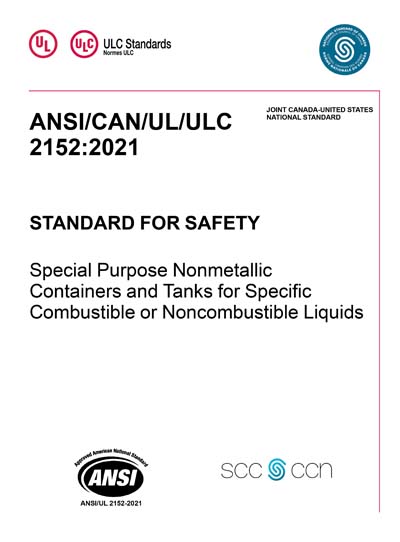Most recent
UL 2152 Ed. 1-2021
ANSI/CAN/UL/ULC Special Purpose Nonmetallic Containers and Tanks for Specific Combustible or Noncombustible Liquids
1.1 These minimum requirements cover special purpose nonmetallic containers and tanks (vessels) for specific aboveground use applications for combustible or non-combustible liquids as indicated for each special purpose type. The requirements address the specific designs, features, limitations, use factors and other unique characteristics of each type. The types of different special purpose vessels covered by this Standard are: a) Liquid Chemical Containers and Tanks designed for stationary storage of combustible or non-combustible liquids in non-residential applications, intended to be used in accordance with . Liquid chemical tanks are limited to the specific liquid(s) or family of similar liquids and application(s) to which they are rated; b) Cooking Oil Tanks designed for storage of cooking oils and fats typically found in restaurant or similar commercial food preparing applications having engineered transfer systems. These tanks are intended for either delivery of fresh oil and/or collection of waste oils through piping networks by trained persons using service trucks with pressure or vacuum pumps. These tanks are limited to Class IIIB oils and fats, and are intended to be installed in cooking oil storage systems used in commercial kitchens, in accordance with ; c) Lube Oil Tanks designed for storage, dispensing and collection of Class IIIB motor oils (such as lubricating, transmission, cooling, etc.), working oils (such as hydraulic, brake, steering, cutting, etc.), and other petroleum or synthetic oils with similar chemical and physical properties used in equipment applications; and d) Vehicle Fluid Tanks for storage, dispensing and collection of non-combustible fluids such as antifreeze/coolants (ethylene-glycol and water mixtures), windshield washer (alcohol, water and detergent mixtures), DEF (nominally 1/3 urea and 2/3 water, diesel exhaust solution), and other optional fluid types typically used in vehicles. Type Liquids stored U.S.A. Regulatory applications Canada Regulatory applications Liquid Chemical Containers and Tanks Combustible and non-combustible [1(a)] Class II or III and non-combustible [16(a)] NFPA 30-9.4 [1(a)] NFC Class II and IIIA containers [2(a)] NFPA 30-9.4.1 (4), etc. [2(a)] NFC Class II and IIIA tanks [2(b)] NFPA 30-9.4.1 (6), etc. [2(b)] NFC Class IIIB [2(c)] – NFC non-combustible [2(c)] – NFC Cooking Oil Tanks Class IIIB oils and fats [1(b)] NFPA 1-66.19.7 or NFPA 30-19.7 [1(b)] NFC Lube Oil Tanks Class IIIB motor oils [1(c)] Vehicle Fluid Tanks Non-combustible [1(d)] 1.2 These requirements do not cover nonmetallic cans, containers or tanks for which there are separately published standards, such as: a) Bulk Shipping Containers intended for commercial transportation applications in accordance with DOT Hazardous Materials Regulations (Title 49 CFR Parts 100-1999), UN Recommendations on Transport of Dangerous Goods (Part 6), or NMFC (Items 256, 258, 294 and 296); b) Consumer Portable Fuel Cans in accordance with ASTM F852, Standard Specification for Portable Gasoline, Kerosene, and Diesel Containers for Consumer Use; c) Portable Containers and Tanks in accordance with UL 75, Outline of Investigation for Portable Containers and Tanks for Flammable and/or Combustible Liquids; d) Commercial Safety Cans in accordance with UL 1313, Standard for Nonmetallic Safety Cans for Petroleum Products, or ULC/ORD-C30, Safety Containers; or e) Oil Burner Tanks in accordance with ANSI/CAN/UL/ULC 2258, Standard for Aboveground Nonmetallic Tanks for Fuel Oil and Other Combustible Liquids. 1.3 All special purpose vessels are factory manufactured atmospheric types of primary, secondary or diked containment designs. The containment materials are formed from primarily thermoplastic or thermoset polymers with or without integrated metallic components. 1.4 In addition to requirements for the vessel's structural integrity, material compatibility, environmental exposures and fire resistance, requirements for optional accessories that may be installed in or on the tank, such as supports, pumps, heaters, gauges, filters, hoses, valves and controls are also provided in this Standard. 1.5 These tanks are intended for installation and use in accordance with applicable documents in the following list: a) In Canada: 1) National Fire Code of Canada; 2) CCME PN1326, Environmental Code of Practice for Aboveground and Underground Storage Tank Systems Containing Petroleum and Allied Petroleum Products; 3) Regulations of the authority having jurisdiction; and b) In the United States: 1) Standard for the Installation of Oil-Burning Equipment, NFPA 31; 2) Flammable and Combustible Liquids Code, NFPA 30; and 3) Code for Motor Fuel Dispensing Facilities and Repair Garages, NFPA 30A, as applicable. 1.6 Any accessories or components not described in 4 that are shipped with, attached to, or added to the tanks are not included in the scope of this Standard. It is intended that the AHJ approve the use and/or installation of any such accessories or components independent of the conformance of a tank to these requirements. 1.7 These requirements do not cover resistance to hurricanes, tornadoes, earthquakes, floods, or other natural disasters; or large-scale fire and excessive damage resistance. In addition, assessment of any damage for continued use after such events, are not included in the scope of this Standard. 1.8 Any common fuel, oil and other liquid terms referenced in this Standard are intended to describe fluids which are commercially available, and which meet the requirements of a recognized industry specification, such as documents published by ASTM, SAE or SCE.
Content Provider
Underwriters Laboratories [ul]






